The Friends of the Wildflower Garden, Inc.
Plants of the Eloise Butler Wildflower Garden
The oldest public wildflower garden in the United States
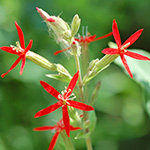
Common Name
Royal Catchfly (Wild Pink)
Scientific Name
Silene regia Sims
Plant Family
Pink (Caryophyllaceae)
Garden Location
Upland
Prime Season
Late Summer
Royal Catchfly is a very distinct and spectacular prairie plant whose range does not include Minnesota, but it can grow quite well here and should be planted by native plant lovers to preserve the species. It can make a spectacular mass of bright color in late summer, matching only the Cardinal Flower in brilliance. In the wild it is suffering habitat loss and is endangered. It is an erect to often reclining perennial with stems that are 1 to 3 feet high, with branching usually only in the inflorescence. The lower section of the stem may be smooth to hairy but the upper parts have fine short hairs which are usually glandular.
The leaves are opposite, at the stem nodes, widely spaced, tapering to pointed tips, rounded stalkless bases and usually hairy on both surfaces. The margins are smooth but frequently wavy and rolled toward the center rib.
The inflorescence is a terminal cyme of stalked flowers, the stalks of the cyme branches are ascending, glandular hairy and with small bracts at the base of each cluster.
Flowers: The flowers are perfect, with a long tubular calyx, green and sometimes tinged with red, with sticky glandular hair and 10 darker nerve lines. The upper section is constricted just before it divides into short pointed lobes, usually 6 but sometimes 8 or 10. The corolla is scarlet with a clawed base and splitting into 5 oblong lobes with rounded, somewhat ragged, tips. Occasionally those tips may split into 2 short lobes. These lobes spread outward almost 90 degrees from the throat of he corolla. There are 3 styles, 10 stamens, all well exserted from the corolla tube. Wide open, the flower often spans 2 inches.
Seeds: Fertile flowers produced a dry seed capsule, inflated to ovoid in shape, narrowed at both ends with the upper end having 6 (or 8 or 10) ascending small teeth. The capsule contains numerous dark reddish brown kidney shaped seeds, each 1-1/2 to 2 mm long, with flattened or concave sides and sharp angles on the margins. These are dispersed by wind shaking the stem. They are immediately viable and do not persist in the soil. It is pollinated by hummingbirds.
Habitat: Royal Catchfly grows best in mesic to wet-mesic prairies, open dry woods, wood edges and thickets that have a more sandy well drained soil, especially calcareous soils. Full sun is preferred. In partial sun the stems will definitely recline. It grows from fleshy taproot and older plants can produce multiple stems. It does not spread vegetatively.
Names: The name 'Catchfly' refers to the sticky calyx which can trap small insects. The genus, Silene, is from the Greek word seilenos and believed to be derived from Silenus who was the foster father of the Greek god Bacchus. Silenus was described as covered with foam, a reference to the white foam frequently found on stems of this genus. The species, regia, means 'royal' or 'princely'. The author name for the plant classification, ‘Sims’ is for John Sims (1749-1831), English botanist, first editor of Curtis’s Botanical Magazine, founding member of the Linnean Society, plant collector and author. He was not the original discover however. That distinction belongs to Thomas Nuttall who first found the plant in 1810, 5 years before Sims published in 1815. Nuttall at the time was under publishing restriction due to his work with Professor Benjamin Barton, but he sent seeds to collectors and from a plant in England obtained from those seeds, Sims made the description and acknowledged Nuttall's contribution (Ref. Charles C. King, 1981, Ohio Biological Survey- PDF).
Comparison: While the stem and leaves resemble those of White Campion, Silene latifolia, and Night-flowering Catchfly, Silene noctiflora, this plant is a perennial with brilliant scarlet flowers instead of white. In color, a close relative is Fire Pink, Silene virginica, but that is a short plant with entirely different leaves.
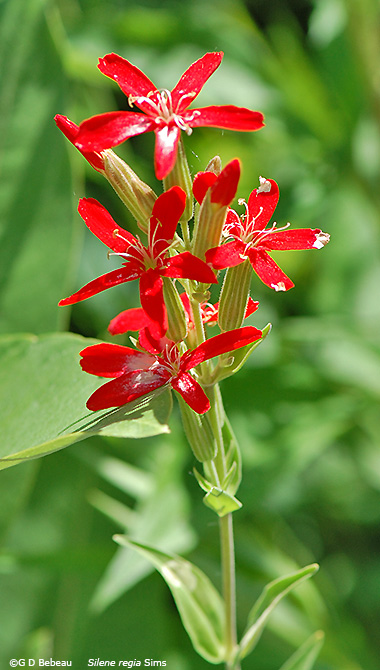
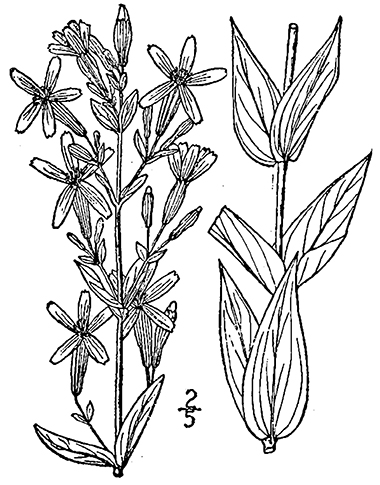
Above: The inflorescence is a terminal cyme of stalked flowers, the stalks of the cyme branches ascending, glandular hairy and with small bracts at the base of each cluster. Drawing from Britton, N.L., and A. Brown. 1913. An Illustrated flora of the northern United States, Canada and the British Possessions. 3 vols. Charles Scribner's Sons, New York.
Below: Flowers have 10 stamens and 3 styles, all exserted from the corolla throat. The calyx has 10 darker nerve lines and is constricted at the tip where the calyx lobes form. Calyx and stalk all with glandular hair. Note the small bracts at the base of the cluster.
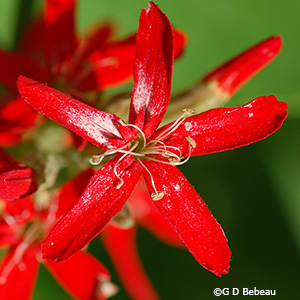
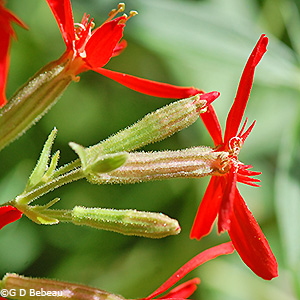
Below: The leaf pairs are widely spaced on the stem, hairy surfaced and stalkless with the margins turned in toward the center rib.
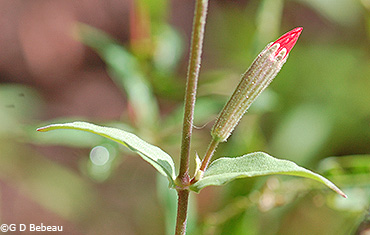
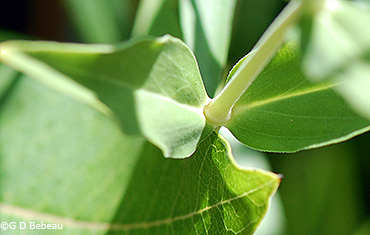
Below: The ovoid seed capsule can have 6, 8 or 10 pointed and spreading teeth at the mouth. Inside are numerous dark reddish brown kidney shaped seeds, each 1-1/2 to 2 mm long, with flattened or concave sides and sharp angles on the margins.
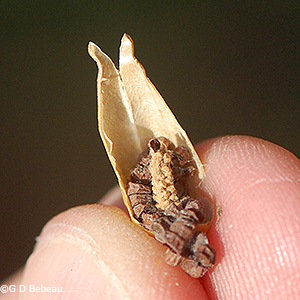
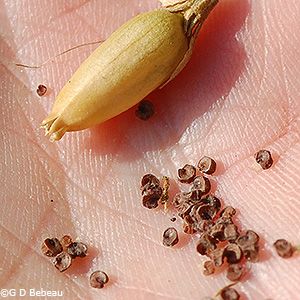
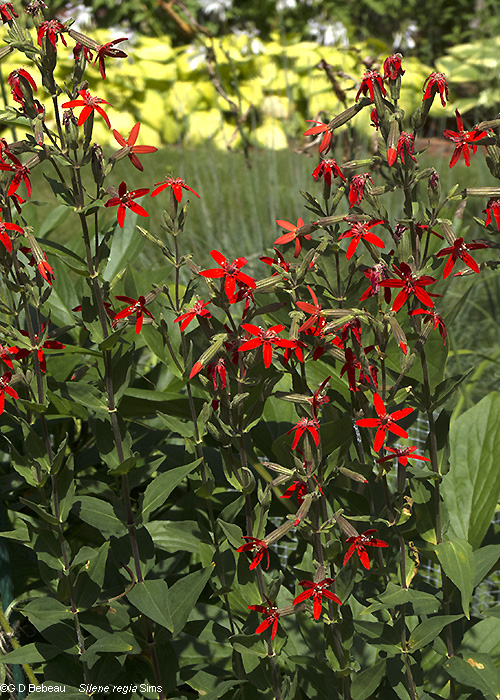
Notes: Royal Catchfly is not native to Minnesota but will grow well here. It made its appearance in the Upland Garden at Eloise Butler when a restored prairie area was replanted. In North America it is only found in the central U.S. states of Ohio, Indiana, Illinois, Kentucky, Tennessee, Arkansas, Kansas, Oklahoma, Alabama, Georgia and Florida. In six of those states it is considered rare, threatened or endangered. Thomas Nuttall called it "one of the most splendid species in existence" in his The Genera of North American Plants and a Catalogue of the Species to the year 1817.
There are twelve Silenes found in Minnesota, 4 native and 8 that are not native. The four Silenes native to Minnesota are: S. antirrhina, Sleepy Catchfly; S. drummondii, Drummond's Campion; S. nivea, Snowy Campion; and S. stellata, Starry Campion.
Return to -- Site Plan/Archive Index --or-- List of Common Plant Names -- or -- List of Scientific Names -- or --Home Page - - - Back to top.
References: Plant characteristics are generally from sources 1A, 32, W2, W3, W7 & W8 plus others as specifically applied. Distribution principally from W1, W2 and 28C. Planting history generally from 1, 4 & 4a. Other sources by specific reference. See Reference List for details.
 Identification booklet for most of the flowering forbs and small flowering shrubs of the Eloise Butler Wildflower Garden. Details Here.
Identification booklet for most of the flowering forbs and small flowering shrubs of the Eloise Butler Wildflower Garden. Details Here.
©2015
Friends of the Wildflower Garden, Inc. Text and photos are by G. D. Bebeau unless otherwise credited. "www.friendsofeloisebutler.org"
042120